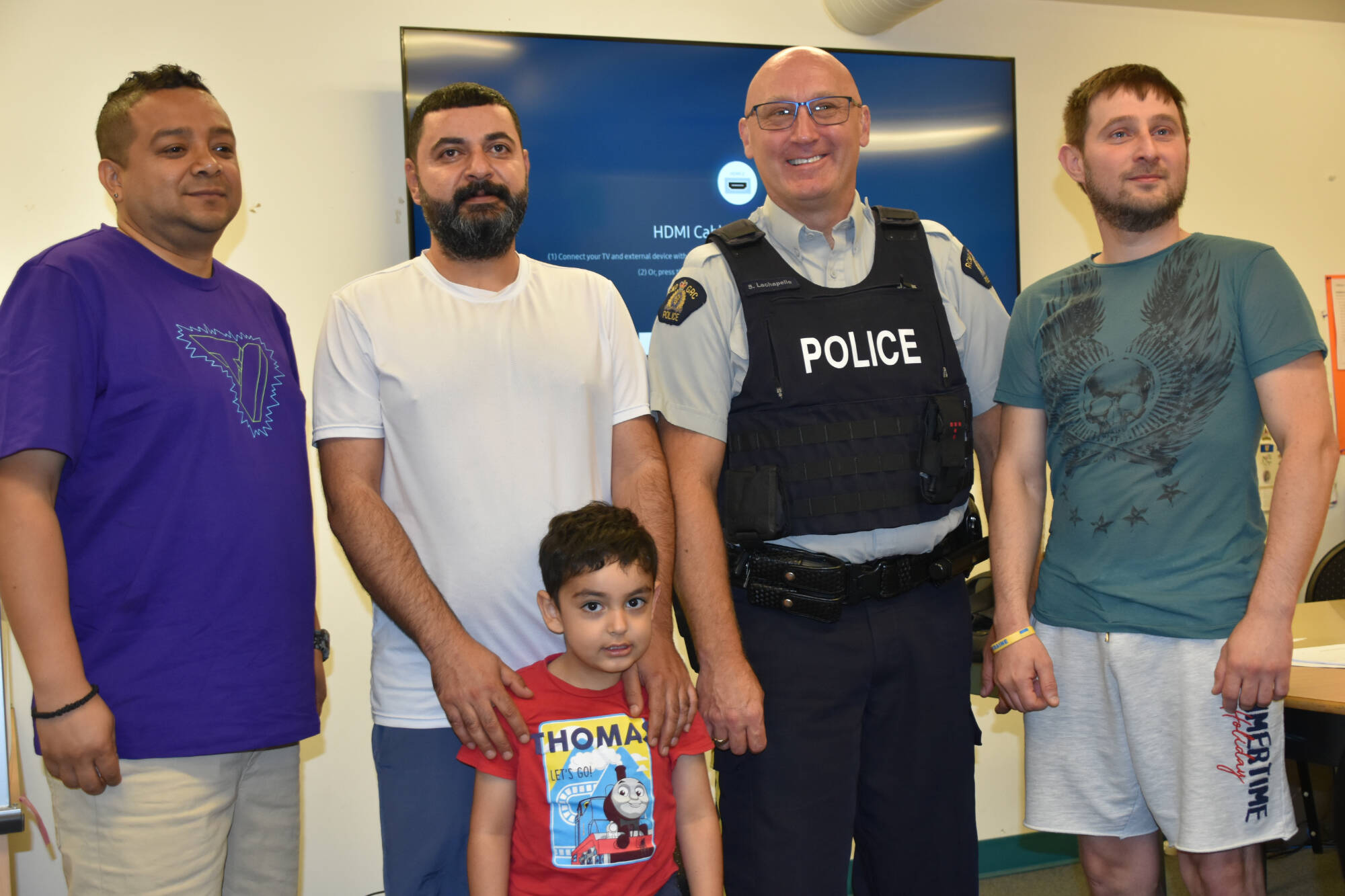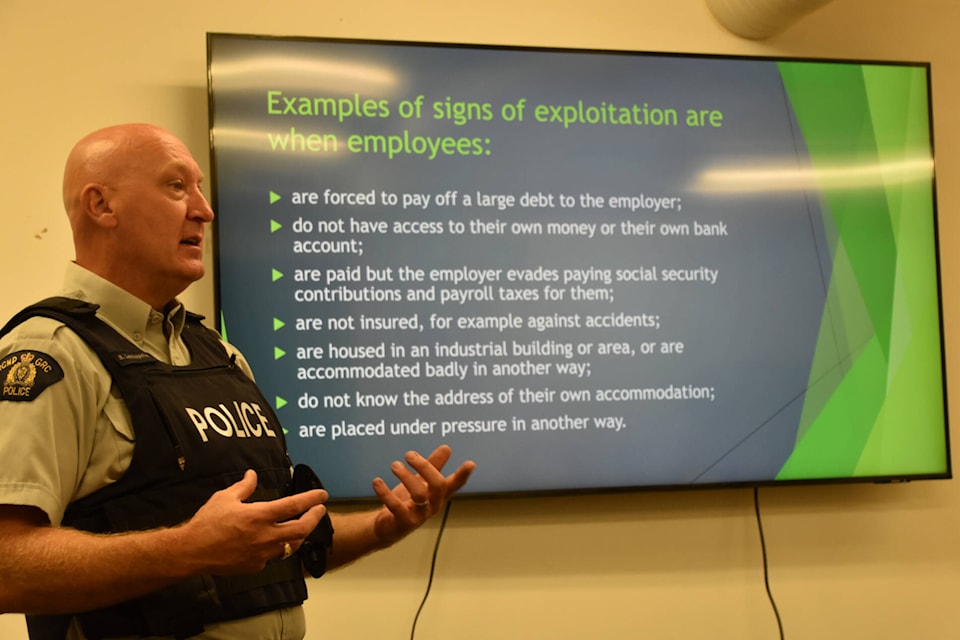Human trafficking is not something that happens only in other countries, nor does it happen only to adults or to people you don’t know.
Salmon Arm Reserve Const. Scott Lachapelle, previously a sergeant with the RCMP before retiring a year ago, emphasized this point during a presentation recently hosted in Salmon Arm by the Shuswap Immigrant Services Society.
Those present heard that traffickers use their victims for providing commercial sex or for other forms of forced labour such as nannies or maids, agricultural workers, sweatshop factory labour and janitorial and food services. Traffickers will trick, defraud, manipulate, threaten or physically force victims. In terms of commercial sex, the victims are mostly women and children.
A sex trafficker often is, perhaps surprisingly, a young man between ages 20 and 24 who preys on girls from 14 to 19, usually 17 to 19, Lachapelle said. Sex trafficking was defined in the presentation as when one person causes another to take part in sexual behaviours to gain something of value.
Read more:
Although those targeted are mostly female, others include LGBTQ2S+ people and youth of any race or gender, often with histories of being marginalized, abused or isolated. Due to the traumatic effects of genocide and residential schools, a disproportionate number of indigenous women, girls and boys are trafficked.
When traffickers recruit, they start by sending friend requests and/or complimenting their intended victim on their social media account, Lachapelle said. If the victim is complaining about home life, they may offer a place to stay.
Traffickers/pimps will often meet their victims at places like fast-food restaurants or outside of schools.
Then they may become ‘boyfriends,’ luring girls with promises of love and protection, a dream of a better life. Then come the gifts, such as clothes, an iPhone, even a pet.
They make their victim feel special, they learn about them, listen to them – they gain information about them to eventually use for victimization. The pimps will control their cellphones, delete their messages, isolate them from their families and steal their identification documents.
Although recruiters are usually men, they can also be women or girls who have been victimized themselves.
Read more:
Lachapelle said the first person in B.C. convicted for human trafficking had 11 victims all under age 19, with the youngest 14. He lured them on social media and offered protections. With two of the victims, he purchased a dog for them and then threatened to kill the dog when they did not return to work for him.
He was given a 23-year sentence for pimping teen girls, Lachapelle said, pointing out that although the perpetrators are difficult to catch, when they are caught, “it’s treated very seriously.”
The threat of exposing the victims to family or friends is often used as a means of control to force trafficked people to perform sexual services, Lachapelle said.
He cautioned that victims may not know they are being victimized because they have a relationship with their trafficker, albeit exploitative. The best approach to help is a non-judgmental approach, he recommended, focusing on the victim and their needs.
An example of things to say or ask to start a conversation about the topic were:
• What would you do if a good looking older guy came up to you at the mall and said he thought you were pretty enough to be a model? Would you give him your phone number?
• What about if a girl you have never met approaches you in the mall and invites you to a party?
• Have any of your friends ever talked about getting paid to go on dates? Or to be “arm candy”?
Read more:
Trafficking also happens within Canada, Lachapelle said. Young girls in Quebec might be brought to B.C., while young girls from B.C. might go to Quebec. They’re kept away from their families.
Human trafficking can also include modern slavery, where victims may end up working in the back of restaurants or in janitorial jobs where they’re not seen by the public.
Lachapelle spoke about an investigation Salmon Arm RCMP were involved in. A family from the Lower Mainland came to the Shuswap for their summer vacation. They had their nanny with them. It was somehow reported to police that the nanny was being forced to work seven days a week, 24 hours a day and paid no money. All the money she made, she was forced to pay back to the family for accommodation.
“That’s an example of what’s taking place in Canada,” Lachapelle said.
Amanda Eastwood with Shuswap Immigrant Services Society agreed the society has seen various people come through its office in similar situations. They’ll be in a house caring for elderly residents or children, for instance, 24 hours per day, but not being paid. They may be given money but then have to pay it back. The victims are told, if they complain, they’ll be in trouble with police in Canada.
Read more:
Lachapelle said that’s what was happening in the Shuswap situation he described.
The victim was from Thailand, she spoke very little English, and when she threatened to leave, the family told her if she left she’d be sent back to Thailand. And she didn’t want to go back to Thailand.
A trafficker may make a promise that he will bring the victim’s family to Canada, but the victim will have to pay $20,000. So the person works and works and works but can never earn or pay off the money. Labourers picking fruit in the Okanagan may be brought in for two to three months, but get no medical coverage. If they get hurt, they’re just pushed aside.
“That’s not acceptable. That kind of work has to be covered.”
Lachapelle said if residents notice, for instance, people living two or three families to a home or being abused in other ways, “you have to get police involved. It has to get reported to us.”
Read more:
An estimated 28 million people in the world are victims of forced labour and a further 22 million are in forced marriages.
This is a significant increase in the last five years, he pointed out. More than two thirds of those forced to marry are female and almost three-quarters are younger than 15. Migrants are more likely to be in forced labour or trafficked than other groups. And more than 3 million children are in forced labour, half of them in commercial sexual exploitation.
More than half of all forced labour occurs in upper middle income or high income countries, Lachapelle said.
“If a woman doesn’t want to get married and she’s made to marry someone in another country, that could be human trafficking,” pointed out Eastwood.
If you or someone you know may be a victim, you can call Canada’s human trafficking hotline at
Read more:
Read more:
newsroom@saobserver.net
Like us on follow us on and subscribe to our daily .




